Search
Places to stay in
South Africa
|
Alldays
|
Bivack Game Lodge
Alldays Limpopo - South Africa
Email Bivack Game Lodge Reservations: booksa@madbookings.com
Each day at Bivack offers adventure and relaxation..
Bivack Game Lodge Facilities
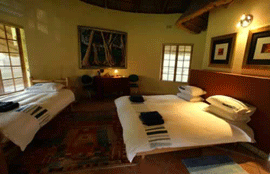 WELCOME
TO BIVACK BUSH SAFARI
WELCOME
TO BIVACK BUSH SAFARI
Escape to the tranquil and untamed world of Bivack Bush Safari..
Flanked by the Mogalakwena River to the east and the mighty Limpopo River
and Tuli Block of Botswana to the north, Bivack has been described as
one of the most beautiful and wildest places in the world.
From the hippos and elephants in the riverine forest of both rivers, to
Eagles Rock High up on the hill overlooking the river valley, each turn
in the bush offers excitement and anticipation for what may appear next.
To truly understand Africa and its beauty, we must seize the opportunities
that it presents to us, and Bivack is exactly that:
Wilderness and nature as far as the eye can see; clear and pollution-free
skies, with nothing disturbing the volume of the stars; warm and friendly
people.
Your experiences here will provide a memory that will continue to linger
for the years to come: This is uniquely Bivack
Bivack Game Lodge Accommodation
AT THE MAIN CAMP
Overlooking the Mogalakwena River (meaning "the place of the crocodile"),
the main camp consists of 7 en-suite chalets that comfortably sleep 20
people.
All chalets are fitted with air-conditioners, hair dryers and en-suite
bathrooms. Bivack is also fully licensed and stocks a wide variety of
beverages.
Our conference facilities
we have capacity for at least 22 people and are equipped with full digital
multimedia and 24 hour broadband internet, making it ideal for productivity
and a relaxing breakaway at the same time!
So relax in Hippo Lounge or around the welcoming camp fire; or spend some
time on the river platform, getting up close and personal with our resident
hippos and crocodiles.
And the cacophony of bird sounds play on..
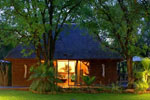
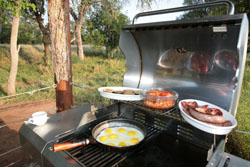
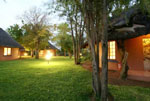
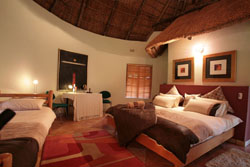
ABOUT BIVACK
And, like most people, Bivack has a story.. More than a hundred years
ago Scottish land surveyors named this 5000-acre wilderness area "Bivack"
(meaning "shelter").
What was behind this, one wonders? Perhaps they realised that in the years
to come Bivack would be a shelter not only for a wide variety of animals
but humans as well.
The Tuli Elephants in particular often visit Bivack from across the Limpopo
River. They come from as far as the Northern Tuli Game Reserve and from
Mashatu
These surveyors were also responsible for naming the nearest town (about
40 km away) Alldays, when the locally brewed "moonshine" (locally
called mampoer) proved too much for them.
Apparently, the one-day blurred into the next and it seems to these men
that the nights were non-existent!
Bivack lies in the Central Limpopo Valley, close to Mapungubwe National
Park - today a world heritage site, it is where South Africa's earliest
civilization lived and prospered more than a thousand years ago.
They left behind a legacy of golden artefacts, pottery and ornaments that
tell the story of our area's past. Bivack forms part of the Lost Kingdoms
Route.
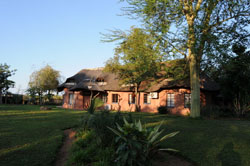
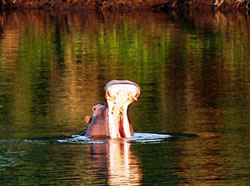

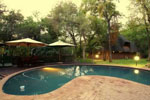
THE BIVACK EXPERIENCE
Each day at Bivack offers adventure and relaxation..
In the morning, a safari walk; for those who enjoy fishing, take some
time to catch some yellow fish, tilapia, mackerel or tiger fish at one
of the many spots along the Limpopo and Mogalakwena Rivers.
Or just relax at the lodge's uniquely mopani pool and soak up the bushveld
in the warm African sunshine.
When the day begins to cool, we set out on a safari drive for sundowners
at Eagle's Rock, a high observation point overlooking the Limpopo valley
and Tuli Block of Botswana.
Later, after dinner which was prepared in our restaurant, a slow burning
boma fire lends the opportunity for companionship and the sharing of big
stories against a background of star-filled African skies.
The staff and management at Bivack have vast experience and knowledge,
but above all a willingness to share their passion for the land with its
many inhabitants, making for a truly memorable experience.
GETTING THERE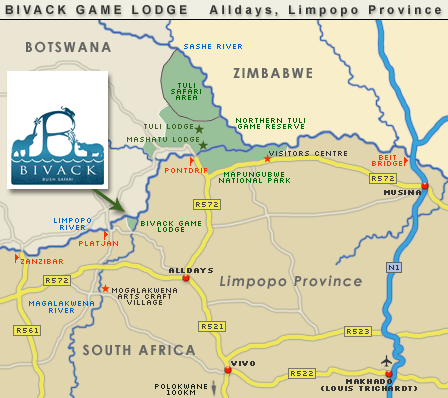
Get ready to discover the undiscovered jewel of Limpopo's game lodges,
a place of utmost African shelter and soothing tranquillity..
By car, Bivack lies just 440 kilometres from Pretoria.
Drive North along the N1 to Polokwane and turn left on the road that passes
Dendron and Vivo to Alldays.
Bivack lies 35 km to the North-West of Alldays.
And by plane, the trip takes only 90 minutes (Bivack has its own well-maintained
runway suitable for aeroplane's up to the size of twin turbine aircraft).
Runway particulars: 1000 m gravel, 03/21, 2200 ft above sea level
Coordinates of the runway: 22 28 49 S and 28 54 07 E
Camp coordinates: 22 28 17 S and 28 55 07 E
EAGLE ROCK
Have you ever looked a Verreaux's Eagle in the eye?
After working our way up Eagles Rock in a 10-seater safari vehicle, we
became eagles! Below us, stretching as far as the eye could see from left
to right was the majestic Limpopo River on its tortuous route of 1500
km to the Indian Ocean.
Beyond the valley was the Tuli Block - an open expanse of land, undeveloped
and wild. We watched as Kudu, Impala and Elephant crossed the river and
we felt free..
EXPLORE OUR HISTORY
Bivack is situated in the Central Limpopo Valley with a rich and diverse
history, dating back more than a thousand years.
Explore the area and discover why early civilizations made this place
their home..
Mapungubwe
Mapungubwe marks the area where South Africa, Zimbabwe and Botswana meet
and is the site of South Africa's earliest civilization, trading with
Africa and the East over 1000 years ago.
They left behind a legacy of gold artefacts, beads pottery and ornaments
that are breathtaking in both scope and artistry.
The national park is 28000 hectares in total, with amongst others, 4x4
eco trails, birds and wildlife such as elephant, giraffe, white rhino,
eland, lions, leopards and hyenas.
Wild dog and lion tracking at Venetia Limpopo Nature Reserve
Venetia Game Reserve is about a one hours drive from Bivack and offers
radio collar tracking of their wild dogs.
Venetia Game Reserve
Horse riding and a visit to the Arts and Crafts Village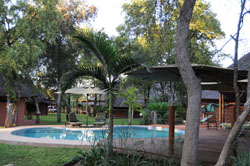
Spend a leisurely morning on horseback at Mogalakwena River Lodge and
Arts and Crafts Village. Rides from novice to experienced can be arranged
by contacting the lodge.
Mogalakwena River Lodge
Rakwena Crocodile Farm
Tour the crocodile breeding pens where 4000 crocodiles hatch per year.
Ratho Bush Camps
Venetia Diamond Mine
This is the only major diamond mine to be developed in South Africa in
the last 25 years and is the country's largest producer of diamonds.
Diamond Route
Special Tours
We also arrange special tours (Cape Town, Bivack and Mashatu Game Reserve
(14 days) for a minimum of 8 people at a time (14 days in total) and which
include most of the above activities.
Please contact us if you wish to make an enquiry!




Animal Sightings
Lion
The lion is not known as the "King of beasts" without reason.
As the largest of the cat family, its strength lies not only in its impressive
muscular presence but also in the size of its family group or pride, the
size of which can be up to 12 in members.
Despite his fearsome reputation, the male lion is surprisingly indulgent
of his offspring, their vigorous play a training ground for their futures
as hunters.
Leopard
Champion of the bush, the leopard is sleek and solitary. Although physically
smaller than the lion, it is bigger in spirit and with its excellent vision
and hearing, makes a formidable nocturnal hunter.
It stalks its prey in complete silence before pouncing on it and killing
it. If it believes its prey is at risk of being snatched, it will drag
its prey up a tree, even where the animals weighs 70 kilograms.
Caracal
One of the smaller cats, a caracal is usually identified by the black
and white markings on its face and the black tuft of hair at the top of
its ears.
The caracal hunts mainly small to medium-size mammals, up to the size
of bushbuck ewes. It stalks its prey as close as possible and then relies
on a direct pounce or short, fast run.
Hippopotamus
This large rotund animal with a mass of up to 2 tons spends much of the
day lying in water, only coming out at night to move to feeding grounds,
sometimes travelling up to 30 kilometers at a time.
The hippo is extremely vocal and its deep roaring grunts and snorts constitute
one of the typical sounds at Bivack (our resident hippo is one of the
reasons we do not encourage people to go walking around at night!)
Elephant
The elephant is the largest land mammal in the world and is easily identified
by its long trunk, large ears and its tusks.
Its trunk is extremely mobile and is almost as efficient as a human's
hand, whereas its large ears assist in cooling the body.
Although the elephant is active in the night and day, it usually rests
in the shade in the heat of the day. Usually a peaceful animal but when
wounded or sick or in defence of a calf, it can be quite dangerous.
Blue Wildebeest
Reaching a weight of up to 250kg, this animal is dark grey in colour,
with a mane of long black hair down the back of the neck and a beard of
black hair on the throat.
Both sexes have horns and they have a black horse-like tail. Blue wildebeest
are mainly grazers, showing a preference for short green grass. Access
to drinking water is essential.
Waterbuck
A large robust animal, it is grey-brown in colour and is easily identified
by the broad white circle on its rump (according to folklore, the waterbuck
walked off with their toilet seats). They are always associated with water,
preferring areas with tall grass as well as woodland.
Giraffe
With its long legs and neck, and the patchwork patterns all over its body,
the giraffe cannot be mistaken for any other species.
Giraffe are very active during the day and night but usually rest during
the hot midday hours. They are primarily browsers, their long necks and
legs giving them access to a wide variety of trees and bushes beyond the
reach of other animals. Although they are generally believed to be silent,
they do have a range of grunting and snorting calls.
Lesser Bushbaby
The Lesser Bushbaby is nocturnal and feeds mainly on the gum of trees
but they also eat insects, which they catch with their hands.
Although they have small heads, their eyes are very large in comparison,
with black rings around them. They are impressive athletes, jumping considerable
distances from branch to branch and tree to tree. The eyes of the Lesser
Bushbaby normally reflect a reddish glow in torchlight.
Cheetah
Also known as the "greyhound of cats" (both because of its appearance
and because of its incredible speed), is probably the most elegant member
of the cat family.
Its distinguishing features are the black dots that appear all over its
body and the black lines ("tear marks") that run from its eyes
to its mouth.
As the fastest mammal on earth, its hunting skills normally involve a
short stalk and then a sprint in for the kill. Although they may reach
top speeds of more than 70km per hour, this can only be sustained for
a few hundred meters.
Rock Dassie
Often found in rock habitat, they are quite small with a stocky build.
Normally they only become active after sunrise, when they lie for some
time in the rocks in the sun to warm up before moving off to feed.
While the group basks in the sun, a "guard" stands watch for
predators, giving a sharp cry if they are disturbed. Feeding usually takes
place on the ground but they will climb trees to feed on leaves, bark
and fruits.
Spotted Hyena
In the past labelled as a cowardly scavenger, it is now known that the
Hyena is an effective hunter. With its extremely powerful jaws, it rips
its prey to pieces, whether hunting alone or in packs.
Numerous dark brown spots or blotches cover its body and its heavily built
forequarters stand higher than its rump. Although nocturnal, they are
often seen in the day as well. They are responsible for some of the most
haunting noises heard around the fireside at Bivack.
Suricate
Small in size, the Suricate frequently stands on its hind legs, using
its tail for support. It is active during the day and lives in groups
of between 5 and 40 in number.
When foraging or on the move, it maintains communication with a constant
soft grunting. It eats mainly insects but is also known to like reptiles
and birds.
Banded Mongoose
This small animal has 10-12 distinctive dark bands on its back (hence
its name). It is highly social species, forming groups of more than 50
members at a time. Like the suricates, they communicate with constant
soft calls and enjoy eating insects, reptiles and birds.
Vervet Monkey
This is a well-known animal with its grizzled grey hair, black face and
typical monkey appearance. Living in troops of up to 20 or more, they
are active in the day and sleep at night in trees.
There is a clear "pecking order" in each group, a fact often
seen on Bivack! They are mainly vegetarian but also eat birds from time
to time. They tend to raid crops and gardens and are consequently heavily
persecuted.
Email Bivack Game Lodge Reservations: booksa@madbookings.com

 More places to stay in and around Alldays
More places to stay in and around Alldays